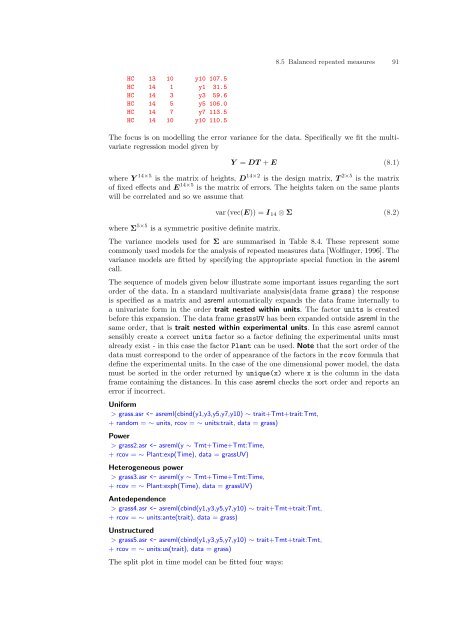ASReml-S reference manual - VSN International
ASReml-S reference manual - VSN International
ASReml-S reference manual - VSN International
- No tags were found...
You also want an ePaper? Increase the reach of your titles
YUMPU automatically turns print PDFs into web optimized ePapers that Google loves.
8.5 Balanced repeated measures 91HC 13 10 y10 107.5HC 14 1 y1 31.5HC 14 3 y3 59.6HC 14 5 y5 106.0HC 14 7 y7 113.5HC 14 10 y10 110.5The focus is on modelling the error variance for the data. Specifically we fit the multivariateregression model given byY = DT + E (8.1)where Y 14×5 is the matrix of heights, D 14×2 is the design matrix, T 2×5 is the matrixof fixed effects and E 14×5 is the matrix of errors. The heights taken on the same plantswill be correlated and so we assume thatwhere Σ 5×5 is a symmetric positive definite matrix.var (vec(E)) = I 14 ⊗ Σ (8.2)The variance models used for Σ are summarised in Table 8.4. These represent somecommonly used models for the analysis of repeated measures data [Wolfinger, 1996]. Thevariance models are fitted by specifying the appropriate special function in the asremlcall.The sequence of models given below illustrate some important issues regarding the sortorder of the data. In a standard multivariate analysis(data frame grass) the responseis specified as a matrix and asreml automatically expands the data frame internally toa univariate form in the order trait nested within units. The factor units is createdbefore this expansion. The data frame grassUV has been expanded outside asreml in thesame order, that is trait nested within experimental units. In this case asreml cannotsensibly create a correct units factor so a factor defining the experimental units mustalready exist - in this case the factor Plant can be used. Note that the sort order of thedata must correspond to the order of appearance of the factors in the rcov formula thatdefine the experimental units. In the case of the one dimensional power model, the datamust be sorted in the order returned by unique(x) where x is the column in the dataframe containing the distances. In this case asreml checks the sort order and reports anerror if incorrect.Uniform> grass.asr grass2.asr grass3.asr grass4.asr grass5.asr
















